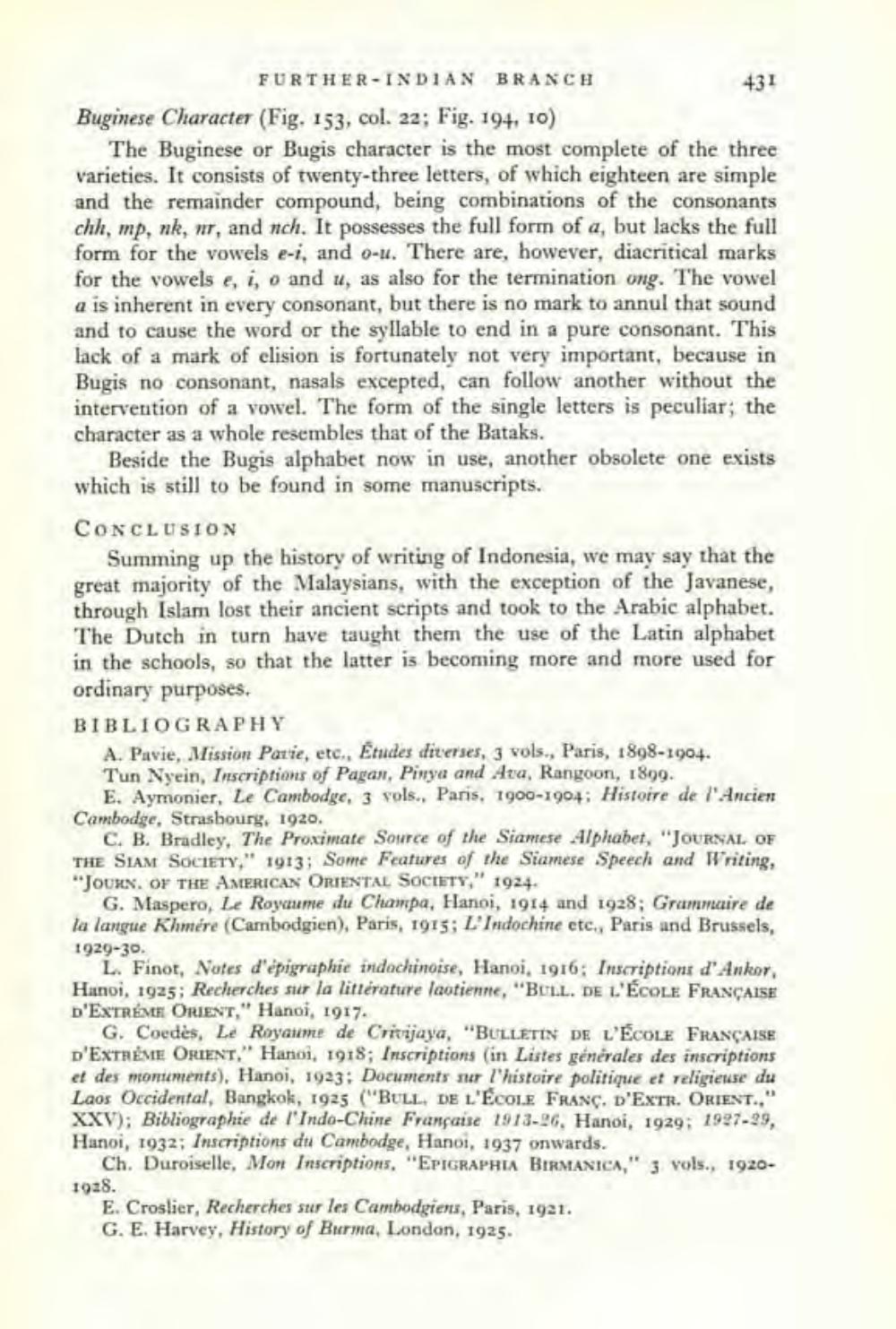________________
FURTHER-INDIAN BRANCH
431 Buginese Character (Fig. 153, col. 22; Fig. 194, 10)
The Buginese or Bugis character is the most complete of the three varieties. It consists of twenty-three letters, of which eighteen are simple and the remainder compound, being combinations of the consonants chh, mp, nk, nt, and nch. It possesses the full form of a, but lacks the full form for the vowels e-i, and O-u. There are, however, diacritical marks for the vowels e, i, o and u, as also for the termination ong. The vowel a is inherent in every consonant, but there is no mark to annul that sound and to cause the word or the syllable to end in a pure consonant. This lack of a mark of clision is fortunately not very important, because in Bugis no consonant, nasals excepted, can follow another without the intervention of a vowel. The form of the single letters is peculiar; the character as a whole resembles that of the Bataks.
Beside the Bugis alphaber now in use, another obsolete one exists which is still to be found in some manuscripts.
CONCLUSION
Summing up the history of writing of Indonesia, we may say that the great majority of the Malaysians, with the exception of the Javanese, through Islam lost their ancient scripts and took to the Arabic alphabet. The Dutch in turn have taught them the use of the Latin alphabet in the schools, so that the latter is becoming more and more used for ordinary purposes. BIBLIOGRAPHY
A. Pavie, Mission Patie, etc., Études diverses, 3 vols., Paris, 1898-1904. Tun Nyein, Inscriptions of Pagan, Pinya and Ava, Rangoon, 1899.
E. Aymonier, Le Cambodge, 3 vols., Paris, 1900-1904; Histoire de l'Ancien Cambodge, Strasbourg, 1920.
C. B. Bradley, The Proximate Source of the Siamese Alphabet, "JOURNAL OF THE SIAM SOCIETY," 1913; Some Features of the Siamese Speech and Writing, "JOURN. OF THE AMERICAN ORIENTAL SOCIETY," 1924.
G. Maspero, Le Royaume du Champa, Hanoi, 1914 and 1928; Grammaire de la langue Khmere (Cambodgien), Paris, 1915; L'Indochine etc., Paris and Brussels, 1929-30.
L. Finot, Notes d'épigraphie indachinoise, Hanoi, 1916: Inscriptions d'Ankor, Hanoi, 1925; Recherches sur la littérature laotienne, "BULL. DE L'ÉCOLE FRANÇAISE D'EXTRÉME ORIENT," Hanoi, 1917.
G. Coedès, Le Royaume de Crivijaya, "BULLETIN DE L'ÉCOLE FRANÇAISE D'EXTREME ORIENT," Hanoi, 1918; Inscriptions (in Listes generales des inscriptions et des monuments), Hanoi, 1923; Documents sur l'histoire politique et religieuse du Laos Occidental, Bangkok, 1925 ("BULL DE L'ECOLE FRANG. D'EXTR. ORIENT.," XXV); Bibliographie de l'Indo-Chine Française 1913-26, Hanoi, 1929: 1927-29, Hanoi, 1932; Inscriptions du Cambodge, Hanoi, 1937 onwards.
Ch. Duroiselle, Mon Inscriptions, "EPIGRAPHIA BIRMANICA, 3 vols., 19201928.
E. Croslier, Recherches sur les Cambodgiens, Paris, 1921. G. E. Harvey, History of Burma, London, 1925.




